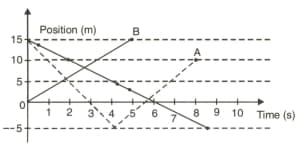Priyanka B Solutions for Chapter: Motion, Exercise 6: Practice Problems
Priyanka B Physics Solutions for Exercise - Priyanka B Solutions for Chapter: Motion, Exercise 6: Practice Problems
Attempt the practice questions on Chapter 1: Motion, Exercise 6: Practice Problems with hints and solutions to strengthen your understanding. Essentials of PHYSICS Class IX solutions are prepared by Experienced Embibe Experts.
Questions from Priyanka B Solutions for Chapter: Motion, Exercise 6: Practice Problems with Hints & Solutions
A body moves with a velocity of for . Then its velocity increases uniformly to in the next . Thereafter its velocity begins to decrease at a uniform rate until it comes to rest after . Plot a velocity-time graph.
A body moves with a velocity of for . Then its velocity increases uniformly to in the next . Thereafter, its velocity begins to decrease at a uniform rate until it comes to rest after . Mark the portions of the graph of uniform motion and non-uniform motion.
A body moves with a velocity of for . Then its velocity increases uniformly to in the next . Thereafter, its velocity begins to decrease at a uniform rate until it comes to rest after . From the graph, find the total distance moved by the body in the initial and the initial and in the last .
A sprinter in a race covers in the first second, in the next , in another and finishes the race in . Calculate the average velocity of the sprinter. You may assume that at any given time interval, velocity is uniform.
A sprinter in a race covers in the first second, in the next , in another and finishes the race in . In which time interval, is the average velocity attained by the sprinter maximum? State this velocity in appropriate units.
A sprinter in a race covers in the first second, in the next , in another and finishes the race in . Plot the distance-time graph for the motion of the sprinter. Assume uniform velocity at all times.
A sprinter in a race covers in the first second, in the next , in another and finishes the race in . Find out the distance moved by the sprinter at the end of with the help of the graph.
Discuss the graphs , and as shown in the figure. Compare the total distance traveled and the displacements. Which portion of the graph represents a motion in which the displacement is zero?

